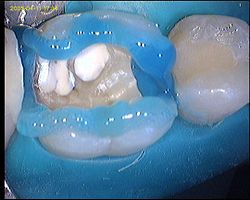Composite
Composite generally means composite material created by the artificial joining of simpler materials. A composite material acquires properties that its individual components do not have by combining them. In dentistry, composite refers to a filling material composed of glass and a resin binder.
Composition[edit | edit source]
- Filler - glass (Sr, Ba), SiO2, Al2O3, B2 O3, phosphates, pigments. [1]
- Binder - resin - monomers and copolymers (BisGMA - bisphenolglycidyl methacrylate, UDMA - urethane methacrylate, TEGMA - triethylene glycol methacrylate), self-solidification inhibitors, initiation system and stabilizers. [1]
- Auxiliary elements - silane - ensures the connection of filler and binder.
Properties[edit | edit source]
Composite belongs to aesthetic filling materials. Holds microretention in the cavity. This means that the surface of the cavity must first be etched in order for the composite filling to have sufficient retention. The composite should be stored hermetically sealed in a cool (5-8 °C) and dark place.
- Advantages
- excellent aesthetics;
- perfect polishability and color fastness;
- excellent adhesion to enamel;
- acid resistance;
- resistance to chewing pressure;
- high toughness.
- Disadvantages
- contraction leading to fractures in the enamel or joints between the filling and enamel;
- poor adhesion to dentin;
- missing anticariogenic properties;
- sensitivity to processing and technological procedures;
- poor removability;
- possible allergic effects.
Classification[edit | edit source]
- According to the method of polymerization
- photocomposite;
- chemically setting (paste/paste);
- dual setting - fixation cements, building materials (bulk fill).
- According to the size of the filler particles
- conventional – particle size 15–100 μm;
- microphilic – particle size 0.01–0.04 μm;
- hybrid – a mixture of three different particle sizes (both of the previous ones and particles with a size of 1-50 μm).
- According to the amount of filler
- up to fifty percent it is not a composite;
- highly charged;
- slightly filled - so-called flow composites.
Indication[edit | edit source]
- fillings I., II., III., IV. and Class V according to Black of small and medium extent, under conditions of good hygiene and localization supragingivally
- wedge-shaped defects of the neck area
- correction of the shape of the teeth
Contraindications[edit | edit source]
- poor oral hygiene of the patient
- bruxism
- if the cavity or part of it is located subgingivally
- if it is impossible to ensure a dry and clean work area
Processing and Application[edit | edit source]
The photocomposite is applied in small layers (batches), each of which is polymerized. Small layers are used to avoid large volume contraction which is undesirable (the resulting hermetic edge seal might not form (in this case most certainly)).
- Etching
- Enamel 30 s
- Dentin 10 s
- Rinsing
- Drying (light, do not dry)
- Primer
- Massage for 30 seconds
- Blowing
- Bond
- Polymerize
- Application of individual small increments until the final appearance with continuous polymerization.
- Finishing, articulation
- Polishing
Links[edit | edit source]
Related Articles[edit | edit source]
- Adhesive Systems
- Making a composite filling
- Filling materials used in the frontal section
- Classification of carious cavities
External links[edit | edit source]
References[edit | edit source]
References[edit | edit source]
- DOSTÁLOVÁ, Tatjana. Stomatologie. 1. edition. Grada Publishing, a.s, 2008. pp. 196. ISBN 978-80-247-2700-4.








